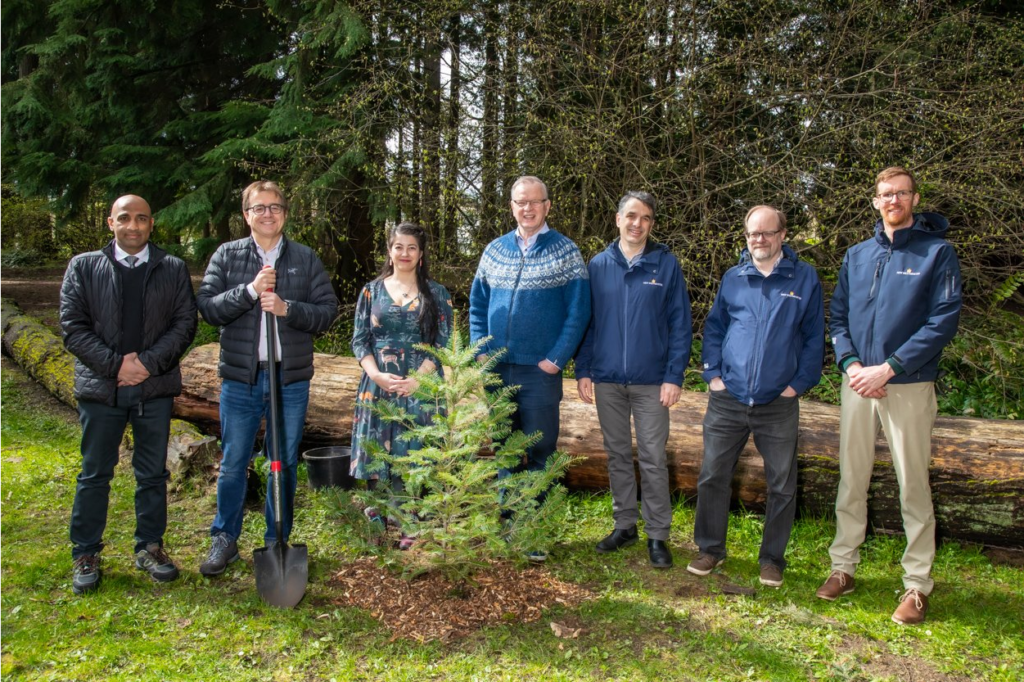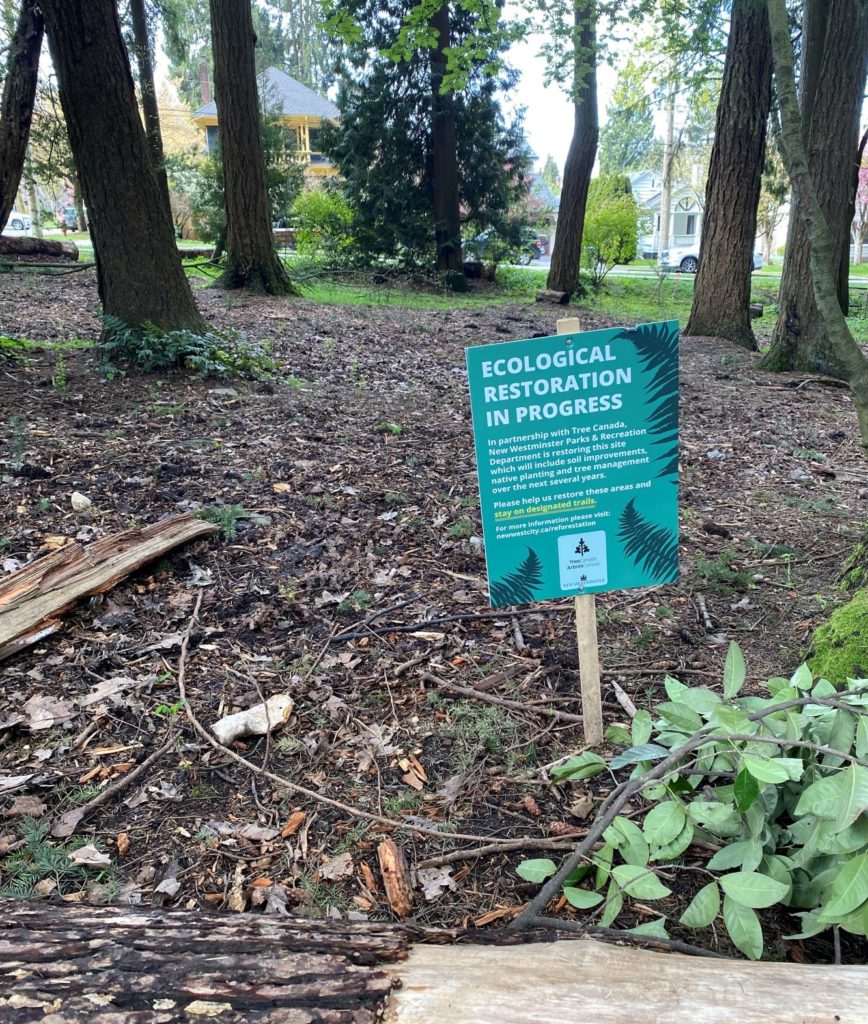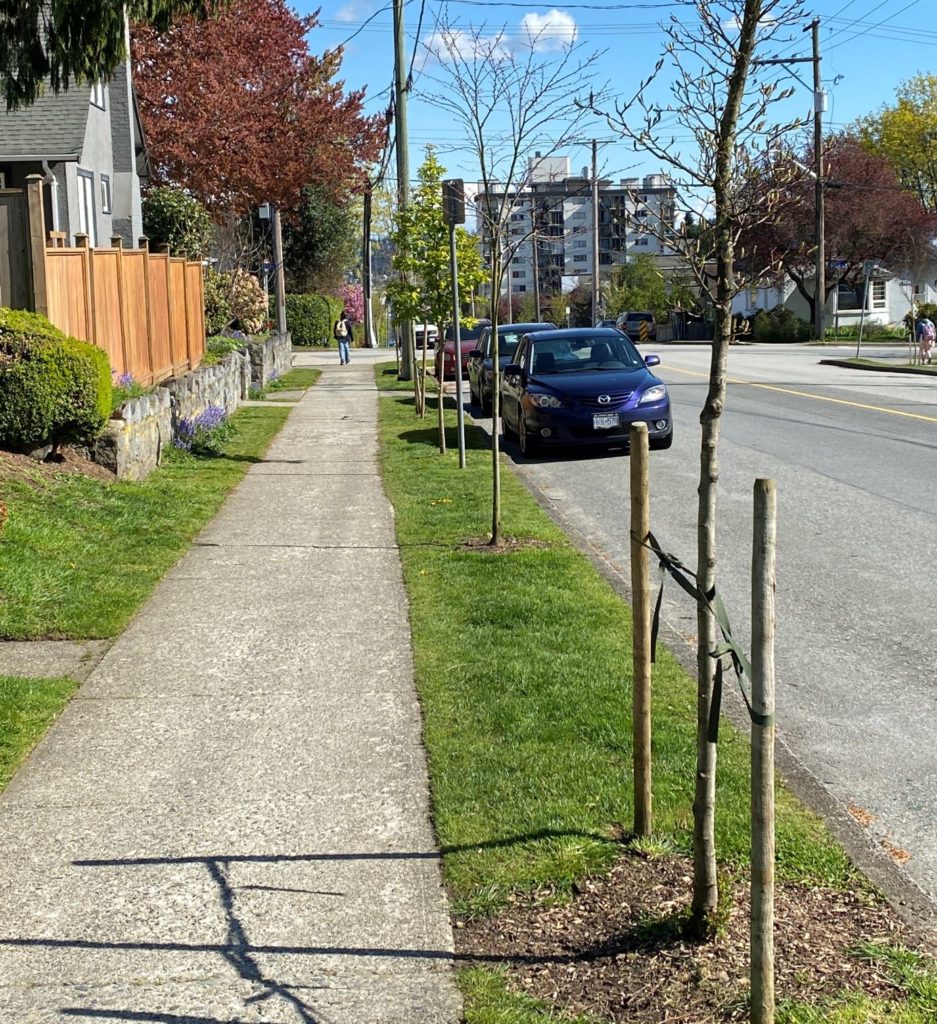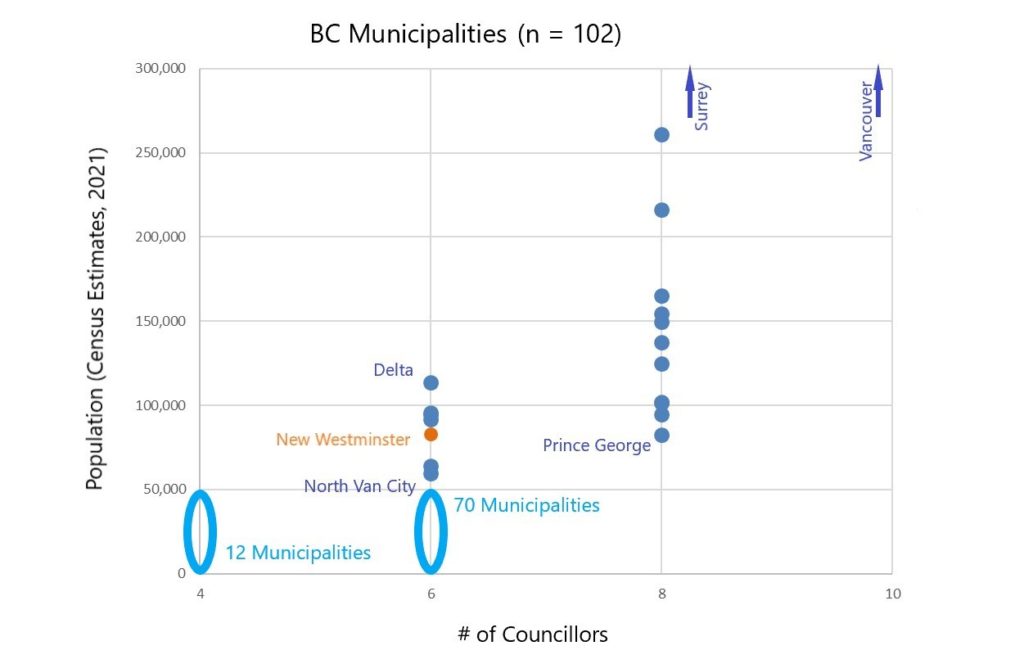Its summer time in New West Council, and things get a little more casual in the chambers, but we had a long Agenda and a decent crowd show up to enjoy the air conditioned spaces and to hear the presentation of the Annual Report. I will put off blogging about the report for a later post, because there is a lot of good stuff in there, and we had three Public Hearing items to get to:
Zoning Amendment Bylaw No. 8341, 2022 for 735 Eighth Avenue (Massey Theatre)
The Massey Theatre Society wants to change their license to get more flexibility and less hassle at the times they want to serve alcohol as part of their events schedule. This is not going to change how they operate much, or any aspect of the building, but it will make it easier for them to operate For the Province to give them that license, it must be permitted in the zoning language, which means if the City supports it, we need to add this language to the zoning, which requires a Public hearing. Here we are.
We received 23 written submissions on this request, all on favour. We had no-one come to address the Public Hearing. The MTS has been operating with event licences for years with no problems, so no surprise. Council voted to adopt the bylaw.
Heritage Revitalization Agreement Bylaw No. 8339, 2022, Heritage Designation Bylaw No. 8340, 2022, and Road Closure Bylaw No.8350, 2022 for 108-118 Royal Avenue and 74-82 First Street
This project has taken a couple of years to evolve from a smaller iteration to where it is now. This will see 189 new strata apartments on Royal Ave in the Downtown, the preservation of a heritage house, and a pretty significant upgrade in the surrounding active transportation network. This includes a long-sought moderate-grade connection from Agnes to Royal via Cunningham and adjacent improvements that addresses some “gaps in the map” for active transportation in the downtown and safe routes to QayQayt.
Every project bring different benefits, this is decent density that will fill a need in the market, homes for 189 families, really important transportation connections, preservation of a couple of historic homes, and though there is maybe more parking than we might need in 2022, they will be 100% pre-wired for EV charging..
We had two written submissions and 6 speakers. Most speakers were in favor, but there was a discussion about the loss of trees on the site. It is very green right now with a variety of trees and almost completely surrounded by hedges, but the arborist report indicated most trees on site were in poor health due to a variety of issues (ivy infestation, historic pruning issues, root concerns, etc.). As per the City’s Urban Forest Management Strategy and Tree Protection Bylaw, the trees will be replaced on a 2-for-1 basis, with 56 new trees on site and another 64 planted around the neighbourhood to add to the citywide tree canopy.
In the end, Council voted to give the project and the Bylaws Third Reading.
Zoning Amendment (Blackley Street) Bylaw No. 8351, 2022 and Road Closure and Dedication Removal (Queensborough Eastern Neighbourhood Node) Bylaw No. 8347, 2022
This is a part of the larger Eastern Node project in Queensborough, which will (eventually, because it is taking some time) provide mixed use housing and some retail commercial to the border of the Port Royal neighbourhood. The Public Hearing today is only in regards to closing, selling off, and rezoning two undeveloped road portions to permit the re-planning of the neighbourhood to facilitate the Eastern Node concept. We had no written submissions or speakers to this issue at Public Hearing, and voted to approve.
Council then moved the following items On Consent:
2021 Statement of Financial Information
Every year we do the SOFI – this is the simplified but formal part of our financial reporting, along with the reporting out on salaries, benefits, and the Audit Report. Short news: The City collected about $244 Million in revenue and spent about $211 Million, meaning we put about $33 Million into reserves (which is there now to apply to our significant Capital Plan). The City has about $103 Million in investments with the Municipal Finance Authority, about $61 Million in long-term debt, and almost $700 Million in tangible capital assets.
My remuneration as a Councillor (which rises a bit every year with CPI) was just under $54,000, and I had $700 in expenses, which were registrations for on-line conferences like Lower Mainland LGA and UBCM.
Amendments to the Elections Procedures Bylaw No. 7985, 2018
The Bylaw required to set out voting procedures in the October election needs to be adopted by July 5. Staff have made some changes to the Bylaw to allow mail-in voting, and to set the dates for the advance voting opportunities. We approved in principle a few meetings ago, but they were run through external counsel, and a few minor edits in language to improve clarity were recommended. So here we are approving as amended. Get ready to get your vote on!
Approval of Climate Action Reserve Fund Bylaw No. 8321, 2022
The City has a bold plan for Climate Action, with aggressive but attainable targets for 2030. These are more important (in my mind) than the 2050 targets, because the shorter-term ones reflect action we need to do now, and cannot rely on some future hopeful technology. If we want to make 2030 targets, it’s gotta be in our budget and operation plans today. It is the Decade of Climate Action according to my friends at the CEA, which means there is some capital investment we need to make today, recognizing in the longer term it will save us money overall ,and that there is significant funding from senior government and other sources to do this work today.
I often make the point to people who will listen that Climate Action is not as much an environmental concern anymore, it is an economic concern. Getting to 2050 with a climate that supports human prosperity will require re-structuring major parts of our economy, and local governments are where the real action needs to occur. The winners in this transition will be those who go into it with their eyes open, their ducks in a row, and (enter third “getting your shit together” metaphor here).
One way we do this in the City is set up dedicated Reserve Funds, like we have for other priority areas. Council can dedicate a portion of annual surpluses to this fund, or can determine other funding sources, such as selling low carbon fuel credits, money received through the CleanBC Local Government Climate Action Program and other senior government supports. This is a mechanism that gives Council oversight (and transparency to the public) to assure money being invested in Climate Action is going towards Climate Action, because it requires Council resolution to draw from this Reserve Fund.
Development Approval Procedures Amendment Bylaw No. 8342, 2022 and Delegation Amendment Bylaw No. 8344, 2022
One of the ways the City is accelerating the development approval process is by delegating some minor development variances to senior staff. If the variances meet established criteria, set out in the Schedules to the Bylaw, then Staff can approve without writing a council report, waiting for a slot in our Council schedule, and asking us to grant the variance. This is not only more efficient and saves everyone time, it is more transparent to applicants and provides more predictability for them, which saves everyone money.
Komagata Maru Dock water lot lease agreement renewal – Amending Agreement No. NEW326-10551F-002
The Dock where the QtoQ lands on the Queensborough side is on a water lot leased from the Port, with a 5-year renewal term. And it’s been 5 years. So we are renewing.
We then addressed the following items, which were Removed from Consent for discussion:
Diversity, Equity, Inclusion and Anti-Racism (DEIAR) Framework
This has been a big piece of internal work in the City that has perhaps not been as visible outside of City Hall, but has been ongoing for more than a year. A DEIAR Framework is both a strategy and a workplan to assure we have a workplace and a workforce that reflects the diversity and values of the community. The report is worthwhile read to understand how and why the way we serve our community needs to be viewed through a lens of equity and justice – from the way we recruit new staff to the way we support employees of the City to the way we engage the public and deliver programs. There is a bit implementation piece to come here, but at this point we are just receiving the report for information. More to come!
eMobility Strategy: Adoption
Another big piece of work over the last year has been doing the strategic groundwork on how the City will adapt to the e-mobility transformation happening. The technology and public expectations are changing fast in this space, and how we adapt to this change will impact our ability to meet our Climate Action goals, as transportation represents about half of our community GHGs.
There are 10 goals and 36 actions in this plan, some we can start right away, some will dip into that Climate Action Reserve Fund we approved today, some are longer-term. There are infrastructure changes proposed, policy changes, and areas for advocacy to senior governments. I could probably write another blog post about this topic (actually there is an Ask Pat in the queue that applies!), so I’ll write more on this under that heading.
Proposed Redistribution of Federal Electoral Districts 2022
The Feds want to change federal electoral districts, and it means New Westminster is once again getting diced as the Feds try to balance population growth in urban areas with vast spaces where the population is just not increasing. This time is a little weirder yet, because after losing part of Coquitlam last redistricting, New West looks to be gaining part of Surrey while Queensborough is separated off. The last time the feds did this 10 years ago, I wrote this blog (My god, I’ve been doing this for that long?!) about how My New Westminster includes Queensborough. I still feel that way.
But there is another issue here in how a solid local-serving MP like Peter Julian does his work, and how this proposal hurts that. A big part of the work at a constituency office is connecting residents with supports they need, be they federal, provincial, or local. An MP’s constituency staff needs to know what services are available in the community they serve, and many of those services are municipal-based. Asking an MP to serve three major Municipal areas with varying supports, like Burnaby, New West, and Surrey, strains their networks, making those supports less accessible to people. I note the proposed MP for the new Richmond East riding would also be asked to represent parts of New West, Richmond, and Delta. It is untenable. An MP does not have the budget to provide a constituency office in every community, or the staff to expand their work across three major urban municipal jurisdictions. MPs are also expected to understand issues impacting local municipalities, and attend events in all of them – spreading an MP across three major urban municipalities just makes them less accessible.
So the City being asked for feedback on this proposal, and we are sending it: We want Q’Boro in the New West riding, and we don’t think our MP should be asked to also serve Surrey.
Temporary Working Space Agreement (GVSD590) for 590 Blackberry Drive to seek Council’s authorization to enter into a Temporary Working Space Agreement with Greater Vancouver Sewerage and Drainage District and Onni Development (Victoria Hill) Corp. (the “Onni”).
There is a big stinking valve in the ground under the top part of the Glenbrook Ravine. Stinking because it directs where combined sewer flow goes. And stinkin because it needs to be replaced. It is located in a part of the ravine that still technically belongs to Onni as part of the Victoria Hill development but is slated to be turned over to the City as Park. So Metro Vancouver needs to enter into a Working Space Agreement – kind of like a short-term lease – to work on the space that doesn’t belong to them. They hope to do the work during “dry season” next summer.
We don’t know the impacts on the trial at this time, but I suggested this needs to come back to Council with more detail on that. The language in the agreement makes reference to reducing inconvenience, but closing that trail for an extended period during the summer will be much more than that. The Glenbrook Ravine is a vitally important park space in the City, and access needs to be secured for residents of the Victoria Hill, Ginger Drive and Sapperton community. So I am asking that we get clarity on maintaining trail access during these works prior to singing the agreement. Perhaps a little stung by another recent Metro Vancouver sewer project, I am sensitive to getting commitments and understanding in writing here. So we will hear back (hopefully) next meeting.
And we read a bunch of Bylaws, with the following Bylaw for Adoption:
Parks and Recreation Fees Amendment Bylaw No. 8343, 2022
This bylaw to adjust our fees to address annual inflation and keep our costs in line with regional comparators was Adopted by Council.
This rapped out first meeting of the week. Yes, you read that right, we are back at it on Thursday for a special crossover episode of New Westminster Public Hearing!



